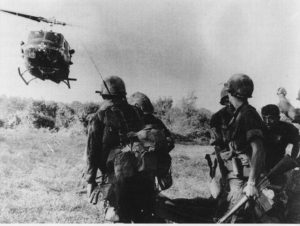Amidst all the death taking place by the coronavirus, last night I decided to rewatch We Were Soldiers, a great movie about the Vietnam War, during which the U.S. national-security establishment sent 58,000 American men to their deaths for nothing.
The movie focuses on the very first battle of the Vietnam War — the battle of la Drang — between U.S. forces and North Vietnamese forces in November 1965. Starring Mel Gibson, Madeleine Stowe, Sam Elliott, Greg Kinnear, and Keri Russell, the movie is based on a true story set forth in the book We Were Soldiers Once … and Young by Army Lt. Col. Hal Moore and reporter Joseph L. Gallaway.
After a U.S. base is attacked in South Vietnam, Moore, who is played by Gibson, is ordered to take 400 men and go after the attackers. They are dropped by helicopters in the la Drang valley in the central highlands of South Vietnam. They soon learn from a captured North Vietnamese soldier that they are facing a 4,000 man North Vietnamese army division. All hell breaks loose.
I was particularly struck by the last words of one young U.S. soldier as he lay dying: “I’m glad I died for my country.”
Except that he didn’t. He didn’t die for his country. He died for his government, which was the entity that ordered him to go to Vietnam and intervene in that nation’s civil war. His country never ordered him to do anything.
Of course, in the minds of national-security state officials, the government and the country are one and the same thing. That’s the mindset that they inculcated in soldiers before sending them to Vietnam. Thus, when U.S. soldiers were fighting, killing, and dying in Vietnam, which is 8,300 miles from the United States, they were necessarily believing, falsely, that they were doing all this for their country.
Actually, the government and the country are two separate and distinct entities. That phenomenon is reflected by the Bill of Rights, which expressly protects the country from the government.
How did U.S. soldiers end up in Vietnam killing and dying and getting injured and maimed?
The answer to that question lies in what happened to the U.S. government after World War II. After partnering with the Soviet Union to defeat the Nazis, U.S. officials converted the U.S. government into what is called a “national-security state,” which is a governmental structure that is opposite to America’s founding governmental system, which was a limited-government republic.
A national-security state is a totalitarian governmental structure, one that wields and exercises totalitarian, dark-side powers, such as engaging in state-sponsored assassinations, coups, invasions, wars of aggression, kidnappings, indefinite detention, medical experimentation on unsuspecting people, mass secret surveillance, and torture.
To place things in context, North Korea is a national-security state. So are China, Cuba, and Egypt. So was America’s wartime partner the Soviet Union, which was now converted into America’s new official enemy, which U.S. officials said was as big a threat, if not bigger, to the U.S. than Nazi Germany had supposedly been.
The argument was that there was a worldwide communist conspiracy to take over the world, including the United States, that was based in Moscow, Russia — yes, the same Russia that today continues to be an obsession for U.S. officials. The Russia obsession was 100 times worse back in the 1950s and 1960s. U.S. officials were convinced that the Reds were coming to get us and install a communist regime here in the United States.
A limited-government republic, they said, was insufficient to defeat the communists in this new “cold war.” To have a chance at prevailing over the Reds, the U.S. government would need to have the same governmental structure as the Soviets and the Chinese, one that would enable them to avoid constitutional restraints on the powers of the federal government.
It was that obsession with communism, the Soviet Union, and Red China, that motivated U.S. officials, especially those in the Pentagon and the CIA, which formed the nucleus of the new national-security state, to send U.S. troops into both Korea and Vietnam.
It never occurred to these people that the wars that were taking place in Korea and Vietnam were nothing more than civil wars. To the paranoid members of the U.S. national-security state, the attempts by North Korea and North Vietnam to unify their countries under communist rule showed that the communists were coming to get us here in the United States. If U.S. soldiers didn’t stop them over there, it wouldn’t be long before the dominoes would fall and the United States would go entirely Red.
It was all just an obsessive and paranoid racket to justify the national-security state’s continued existence and its ever-growing power and largess within the overall U.S. governmental structure. This was confirmed when North Vietnam ultimately defeated U.S. forces and unified Vietnam under communist rule. The dominoes didn’t fall, and while the U.S. adopted socialist economic policies, it never fell to the communists.
By that time, however, the U.S. national-security state had sacrificed some 91,000 American men for nothing in Korea and Vietnam. Undoubtedly, most of those soldiers died convinced that they were dying for their country rather than for their paranoid and obsessive governmental structure known as a national-security state.




